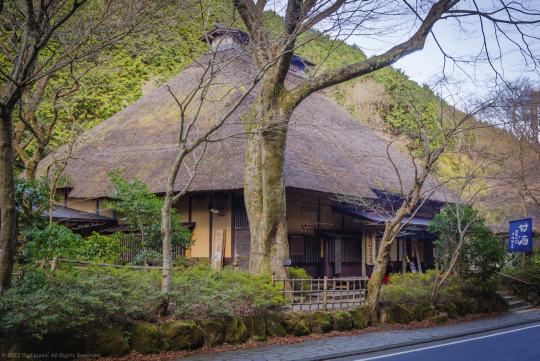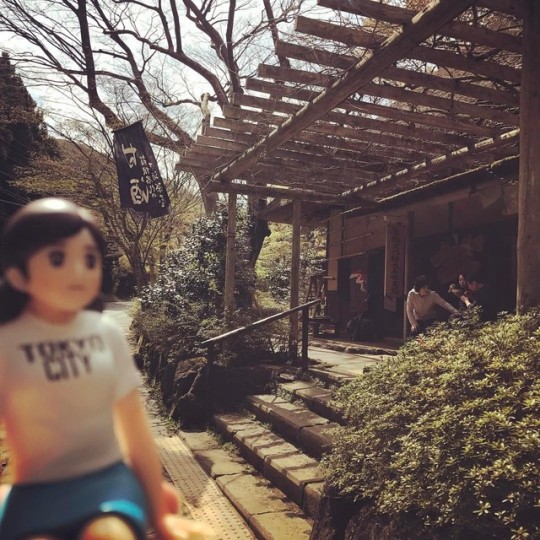#Amazake-chaya
Photo

Historical Teahouse
According to a 2008 interview of the proprietor, Tatsuo Yamamoto, the Amazake-chaya Teahouse was established in the early 1600s during the Edo Period (1603 to 1867) to provide relief and refreshments to travelers on the ancient Tokaido Road, a cobblestone “highway” that linked the imperial court in Kyoto with seat of the Shogunate in Edo (modern-day Tokyo).
The interview with Mr. Yamamoto revealed that he had hopes that his son, Satoshi, would take over for him if and when the time was right. Since that interview in 2008, I can happily confirm that Mr. Yamamoto’s son, Satoshi, has indeed succeeded his father in operating the teahouse by the same family for 13 generations!
Pentax K-1 II + DFA 28-105mm F3.5-5.6
28 mm ISO 100 for 1/125 sec. at ƒ/4.5
#風景写真#神奈川県#旧東海道#旧街道石畳#箱根旅行#甘酒茶屋#pix4japan#pentax_dfa28105#pentaxk1mkii#Japan#Amazake-chaya#Hakone#Tokaido#teahouse#travel photography
23 notes
·
View notes
Photo

Amazake at the 400 year old Amazake-chaya teahouse, a rest stop along the Old Hakone Highway, Japan
0 notes
Photo

Generations ago, Junko's family first opened Amazake-Chaya Tea House in Hakone. These days, it's the only traditional Japanese Tea House left along the Old Tokaido Highway. I first met Junko and her daughter, Kotoyo (), while visiting Hakone with a friend a few weeks ago. My first taste of amazake was wonderful. Right there, I fell in love with Hakone: the gorgeous landscape, the atmosphere of the tea house, Junko's sweet smile, the sparkle in Kotoyo's eye and commitment to her family... 💁🏼 So, I was back this weekend with the hubs in tow for our anniversary celebration (celebrating early as he'll be deployed when June 6th rolls around)! (at Amazake-Chaya)
1 note
·
View note
Photo

Snacking around Hakone #amazake #mochi #montblanc #paripari #monburan #icecream #evaya #mochi #umecyder #fritters #hakone #chaya #snack #sweets #food (at Hakone)
#hakone#umecyder#montblanc#amazake#paripari#sweets#evaya#mochi#chaya#fritters#food#monburan#snack#icecream
0 notes
Photo

Amasake and tea at Amazake Chaya Tea House in Hakone. I hiked over an hour along slippery cobblestone to get to this tea house. Meanwhile, most everyone else just drove or took the bus... #tea #teahouse #amasake #amazake #hakone #Japan #Japanese #hotspring #town #travel #adventure #Canadian
0 notes
Photo

400-Year-Old Teahouse
(Hakone, Kanagawa Pref., Japan)
Amazake-chaya Teahouse has been serving travelers its famous amazake drink for most of its history dating back to the early 1600s.
Their menu is very simple and includes mochi (glutinous rice that is steamed and pounded into a paste) that is grilled over charcoals and coated in isobe soy sauce, uguisu sweet young soy bean powder, or uguisu mixed with black sesame seeds.
The shop’s namesake drink, amazake, is a traditional fermented rice drink. The teahouse has been using the same recipe for 13 generations where no yeast is used, thus resulting in a naturally sweet drink that has no alcohol.
The drink has a texture closer to rice porridge rather than sake, is loaded with lots of nutrients, and is often served or sold at temples and shrines during winter festivals.
Pentax K-1 II + DFA 28-105mm F3.5-5.6
40 mm ISO 100 for 1/13 sec. at ƒ/11
#風景写真#神奈川県#旧東海道#旧街道石畳#箱根#甘酒茶屋#pix4japan#pentax_dfa28105#pentaxk1mkii#Japan#Amazake-chaya#Hakone#tokaido#teahouse#travel photography
17 notes
·
View notes
Photo

Sunken Hearth at Teahouse
(Hakone, Kanagawa Prefecture, Japan)
The Amazake-chaya Teahouse has retained its charm dating back to the early 1600s. The entrance still has the hard earthen floor where wooden tables and chairs are made available for guests.
Farther back are the more traditional woven straw tatami mats where guests sit on the mats and enjoy their drinks and food on knee-high tables.
The centerpiece of the interior is the irori (open sunken hearth), which has a unique figure-8 shape (typical irori are square or rectangular) surrounded by beautiful hardwood flooring.
In this shot, you can also see the jizaikagi—a contraption that includes a pothook attached to a rope that runs through a bamboo pole and extends up to the ceiling timber directly over the irori. The height of the pothook can be changed to adjust the temperature of the food or liquid in the pot.
Irori were common in the main living room of traditional Japanese homes where wood, charcoal, or even coal was burned. Upper-class homes would have had an additional irori in the tea ceremony room where smokeless charcoal was used.
Irori also provided homes with some lighting at night, heat for the main room, and could be used to dry wet laundry, cook food, boil water, and to dry fish and fruit.
Smoke from the irori, specifically the tar in the smoke, was also an essential component for preserving the structural integrity of thatched-roof buildings. While the heat from the irori drew moisture from the building’s timbers and thatched roof to prevent rot and mold, the tar from the smoke would coat and permeate the wooden beams and underside of the thatched roof helping to further prevent mold and rot, and was especially effective at repelling pests, and added an extra layer of waterproofing against rain and snow.
Fujifilm X100V (23 mm) with 5% diffusion filter
ISO 3200 for 1/4 sec. at ƒ/2.0
Astia/Soft film simulation
#風景写真#神奈川県#旧東海道#箱根#甘酒茶屋#囲炉裏#pix4japan#Fujifilm#Fujifilm X100V#Astia Soft film simulation#Japan#Amazake-chaya#Hakone#Tokaido#irori#teahouse#travel photography
15 notes
·
View notes
Photo

Amazake-Chaya teahouse interior. #amazakechaya #earthenfloor #teahouse (at Amazake-Chaya)
0 notes
